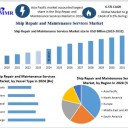
The Ship Repair and Maintenance Services Market size was valued at USD 36.48 Billion in 2024 and the total Ship Repair and Maintenance Services revenue is expected to grow at a CAGR of 6.5% from 2025 to 2032, reaching nearly USD 60.38 Billion.
Ship Repair and Maintenance Services Market Size Worth USD 60.38 Billion by 2032 | Driven by Aging Vessel Fleet and Rising Seaborne TradeThe Ship Repair and Maintenance Services Market was valued at USD 36.48 billion in 2024 and is projected to reach USD 60.38 billion by 2032, growing at a CAGR of 6.5% during the forecast period (2025–2032). This growth is fueled by increasing global seaborne trade, government support for shipyards, and technological advancements such as IoT-enabled maintenance solutions.
To know the most attractive segments, click here for a free sample of the report: https://www.maximizemarketresearch.com/request-sample/104905/" target="_blank"> https://www.maximizemarketresearch.com/request-sample/104905/
Market Overview
The ship repair and maintenance sector plays a critical role in supporting global maritime operations by ensuring the reliability, safety, and efficiency of vessels. Although the market faced a temporary downturn due to COVID-19 lockdowns and supply chain disruptions, it has since rebounded, backed by expanding trade volumes, aging fleets, and favorable policy frameworks across major maritime economies.
Shipyards in several nations benefit from tax incentives and financial aid aimed at strengthening domestic shipbuilding and repair capabilities. For example, Malaysia’s Ministry of International Trade and Industry offers tax breaks for ship repair enterprises, while the U.S. Department of Maritime Administration funds small shipyard projects to enhance infrastructure and workforce training. Similarly, India’s government has granted shipbuilding and repair activities infrastructure status, promoting industry expansion.
Market Dynamics
Key Growth Drivers
Rising Seaborne Trade: Over 90% of global trade depends on maritime transport, increasing the demand for vessel upkeep and modernization.
Aging Vessel Fleet: A growing proportion of vessels are over 20 years old, heightening the need for regular maintenance.
Government Support and Tax Incentives: Policy measures across Asia, North America, and Europe are encouraging investment in ship repair facilities.
Technological Integration (IoT): The use of IoT-enabled sensors and analytics is transforming predictive maintenance and operational efficiency.
Restraints
High Maintenance Costs: The cost-intensive nature of ship repair activities continues to hinder small operators.
Limited Marine Exports in Some Regions: Countries with weak shipbuilding infrastructure experience slower market growth.
Market Trends
1. IoT-Driven Smart Maintenance
IoT technologies enable real-time monitoring of ship systems, optimizing maintenance schedules and reducing operational downtime. Ship repair companies are increasingly adopting IoT-based solutions to track engine performance, fuel efficiency, and equipment wear.
2. Shift Toward Eco-Friendly Repair Practices
To reduce environmental hazards, shipyards are moving away from abrasive shot blasting toward ultra-high-pressure water blasting systems. This technique, adopted by companies such as Watex Corporation, offers sustainable cleaning with water recycling and zero chemical waste.
Segmentation Analysis
By Vessel Type
Cargo Ships – Dominating segment with ~60% market share; driven by global commodity trade and logistics demand.
Offshore Vessels
Naval Ships
Tankers
Workboats
By Repair Type
Electrical and Instrumentation Repairs – Fastest-growing category due to the need for motor, generator, and control system maintenance.
Mechanical Repairs
Main Engine Maintenance & Repairs
Emergency Repairs
Underwater Cleaning and Repairs
By Application
Dockage – Expected to grow at a CAGR of 7.7%, boosted by increasing port infrastructure modernization.
Hull Part Repairs – Estimated CAGR of 7.3% driven by corrosion control and fuel efficiency needs.
Engine Parts
Electric Works
To know the most attractive segments, click here for a free sample of the report: https://www.maximizemarketresearch.com/request-sample/104905/" target="_blank"> https://www.maximizemarketresearch.com/request-sample/104905/
Regional Insights
Asia Pacific
Holding a 50.9% market share in 2024, the Asia Pacific region dominates the global ship repair and maintenance services market. China, South Korea, and Japan lead shipbuilding and repair operations, accounting for over 93% of the world’s ship construction. The region benefits from rapid economic growth, tax incentives, and robust seaborne trade.
Middle East & Africa
These regions are witnessing steady growth (CAGR of 2–3%) owing to expanding marine commerce, port development projects, and rising investment in offshore infrastructure.
North America & Europe
Both regions are seeing renewed interest in naval ship maintenance and modernization programs, particularly in the U.S., Germany, and the U.K.
Competitive Landscape
The global ship repair and maintenance services market is highly competitive, featuring established players and emerging regional firms. Key strategies include mergers and acquisitions, technological innovations, and expansion into high-demand regions.
Major Players Include:
Cosco Shipyard Group Co., Ltd
Damen Shipyards Group
Hyundai Mipo Dockyard
Cochin Shipyard Limited
Hanjin Heavy Industries
China Shipbuilding Industry Corporation (CSIC)
Sembcorp Marine Ltd
Fincantieri S.p.A
Keppel Offshore and Marine
United Shipbuilding Corporation
Oman Drydock Company
Arab Shipbuilding and Repair Yard
Orskov Yard A/S
Tsuneishi Holdings Corporation
Dae Sun Shipbuilding & Engineering Co. Ltd
For instance, Titan Acquisition Holdings’ acquisition of Huntington Ingalls Industries in 2024 strengthened its defense-oriented ship repair capabilities, while Hyundai Mipo Dockyard secured a KRW 110 billion contract from Evergreen Marine for eco-friendly container ships.
Conclusion
The Ship Repair and Maintenance Services Market is set for robust growth through 2032, driven by digital transformation, sustainability trends, and expanding global trade. Asia Pacific will continue to lead, while Europe and North America will see modernization-led opportunities.
With governments actively supporting shipyard development and operators embracing IoT and green technologies, the industry’s long-term outlook remains highly optimistic.






 supriyamaximize
supriyamaximize
 poojammr
poojammr Blakesmith
Blakesmith Erica111
Erica111